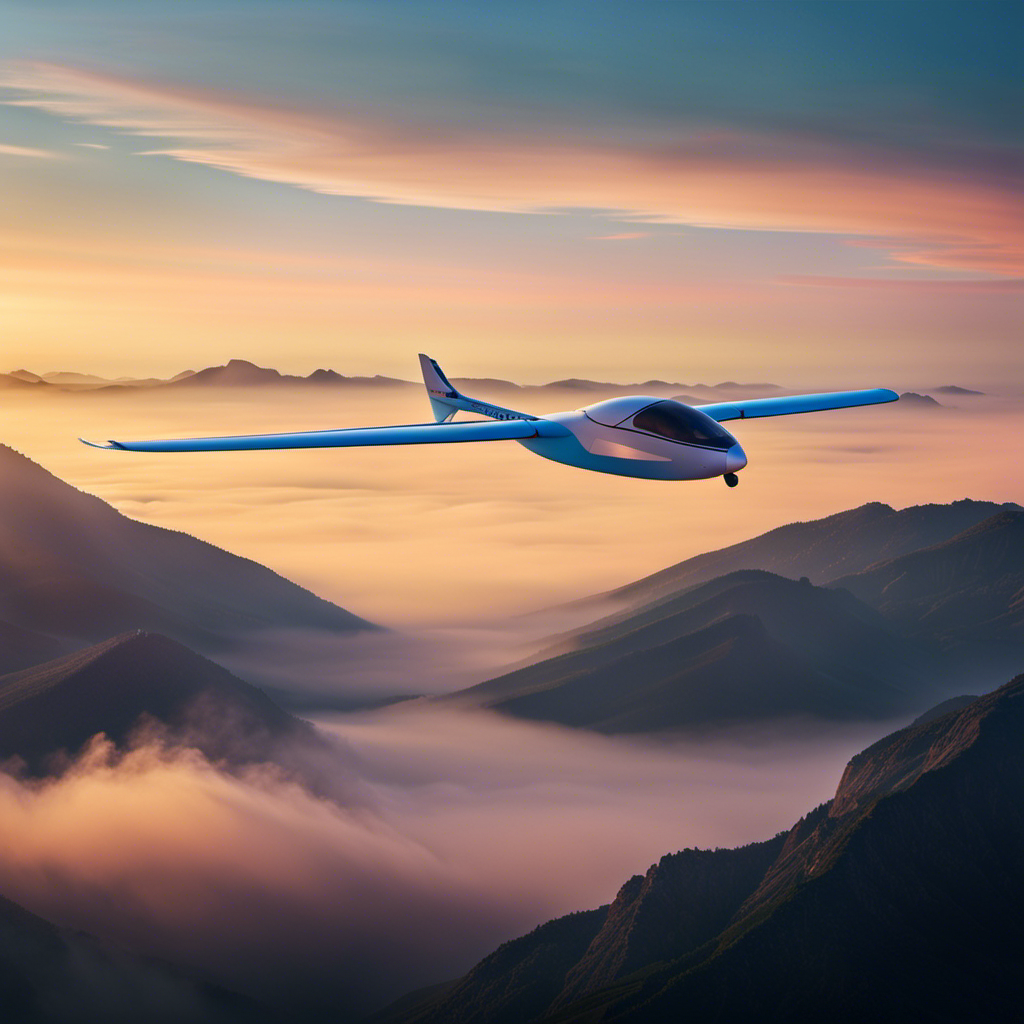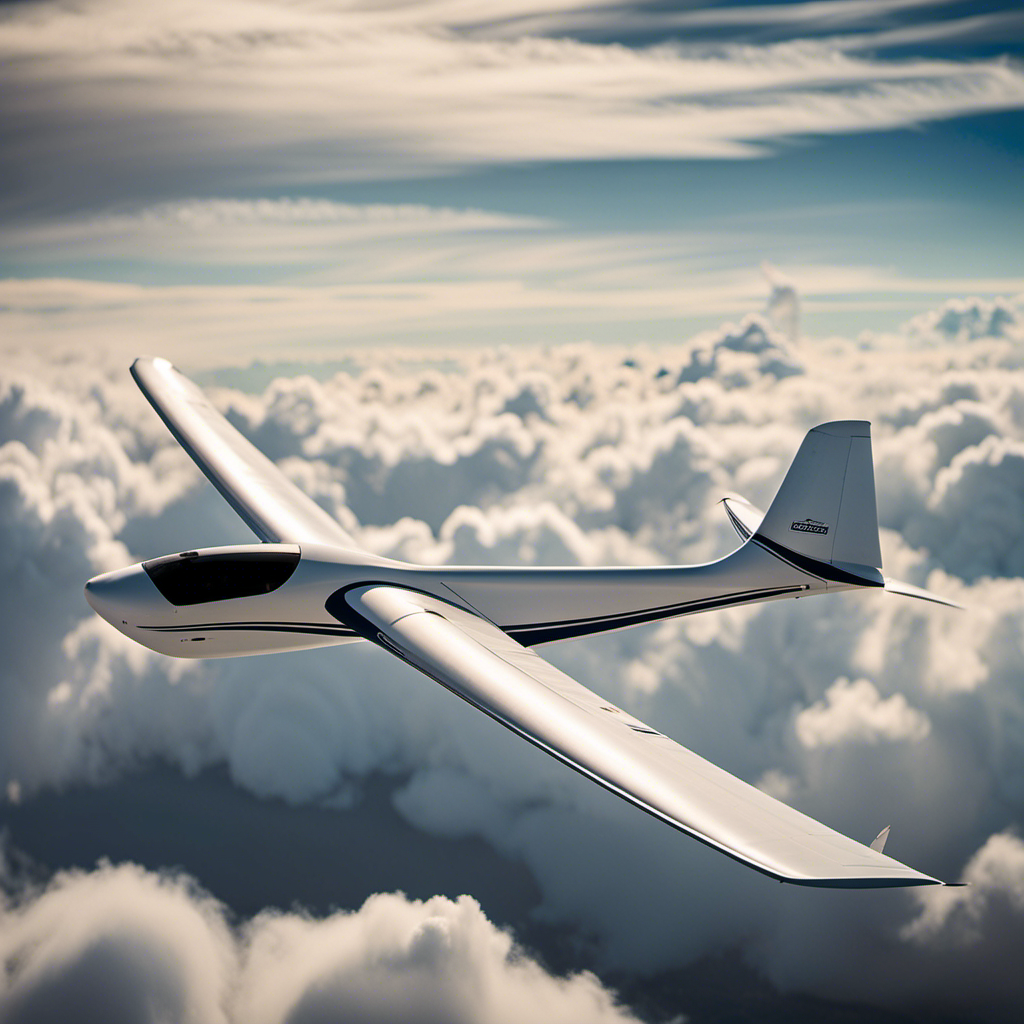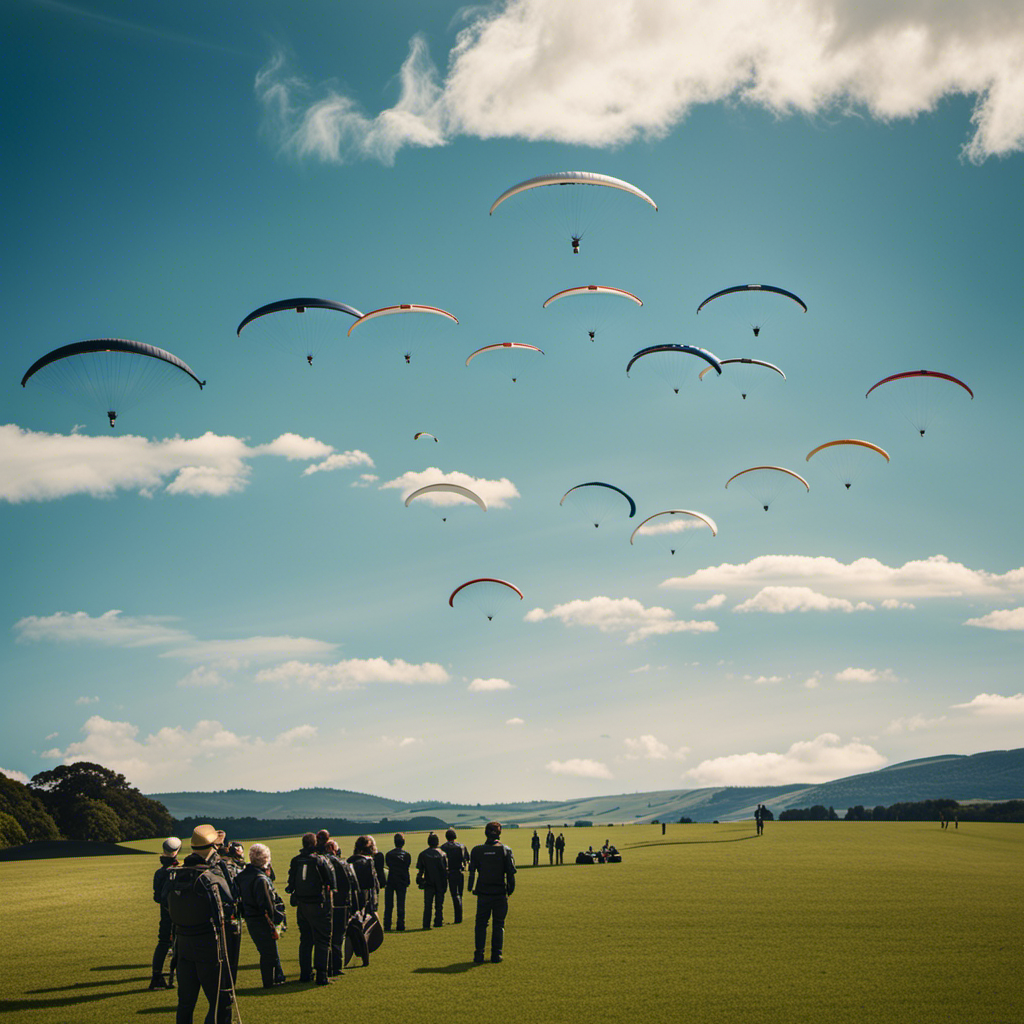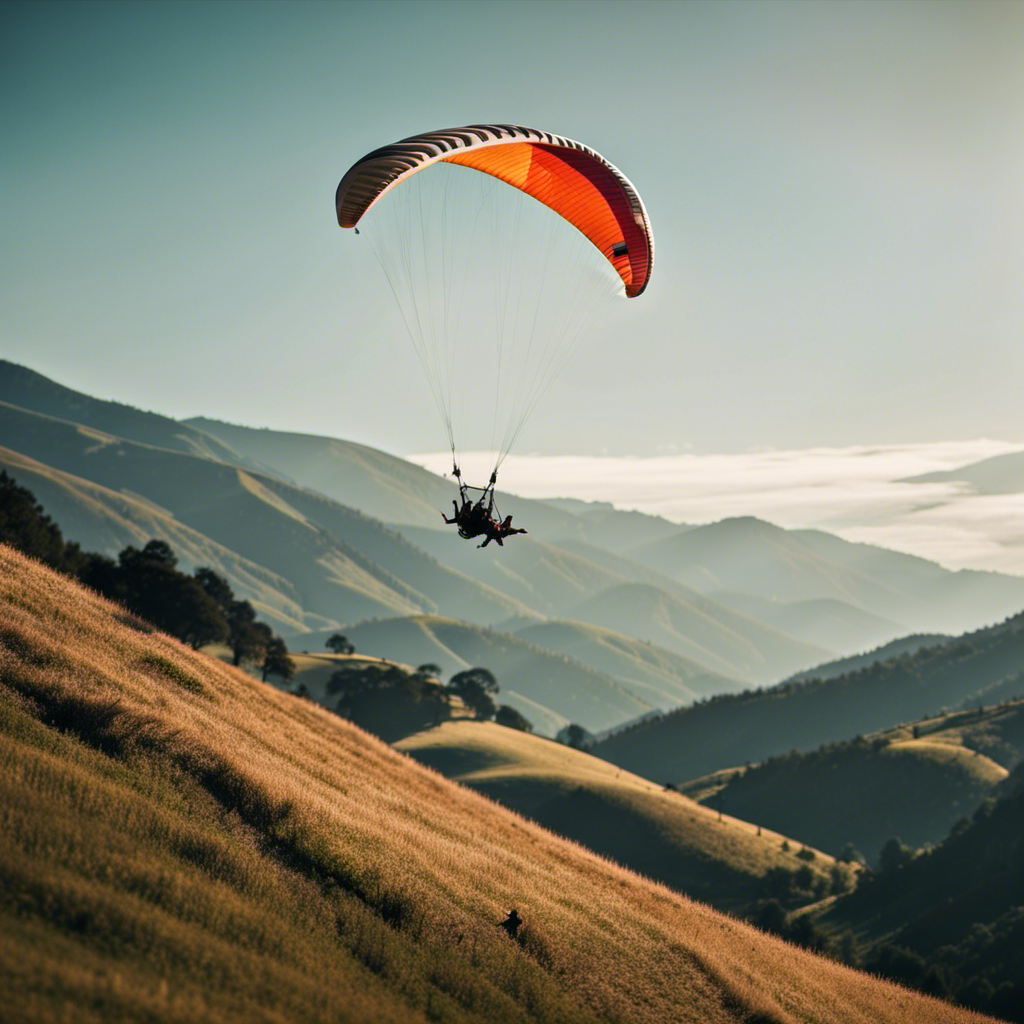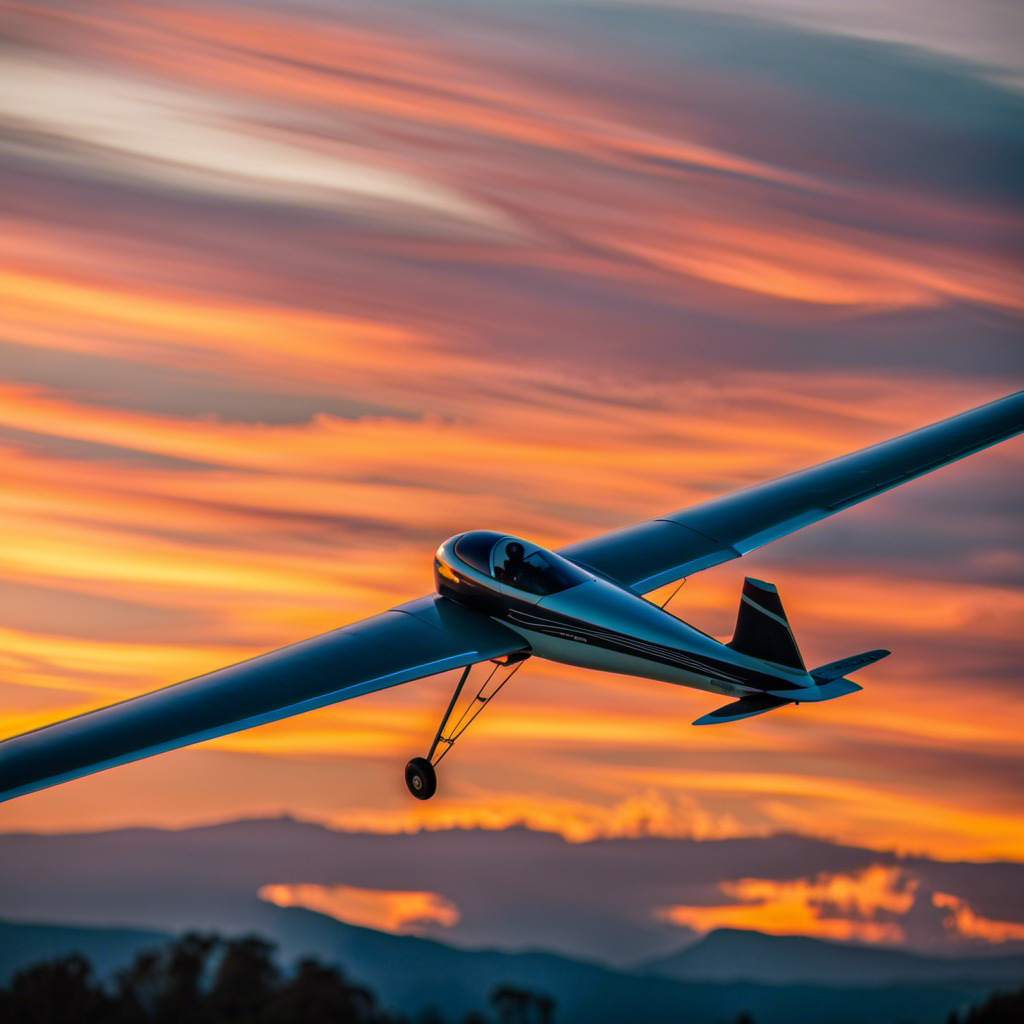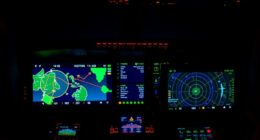I have always been deeply intrigued by the aviation industry, and it was only recently that I came across a truly revolutionary finding: the electric self-launch glider.
Did you know that these cutting-edge aircraft are becoming increasingly popular among pilots? With their electric propulsion system, they offer a whole new level of freedom and flexibility in the skies.
In this article, I will delve into the benefits of these gliders, explain how their propulsion system works, and provide valuable insights for pilots of all experience levels.
So, buckle up and get ready to soar on your own terms!
Key Takeaways
- Electric self-launch gliders provide an exhilarating flying experience.
- Electric self-launch gliders have a positive environmental impact, reducing carbon footprint and minimizing air pollution.
- Electric self-launch gliders offer cost efficiency by eliminating the need for expensive tow planes or winches and reducing operational and maintenance costs.
- The electric propulsion system of self-launch gliders allows for effortless ascension, smooth gliding, enhanced safety and control, and adjustable motor output.
The Benefits of Electric Self Launch Glider
You’ll love the benefits of an electric self-launch glider! Not only does it provide an exhilarating flying experience, but it also has a positive environmental impact and is cost-efficient.
When it comes to the environment, traditional gliders rely on tow planes or winches to gain altitude, which consume fossil fuels and emit harmful greenhouse gases. In contrast, an electric self-launch glider utilizes an electric propulsion system, reducing its carbon footprint and minimizing air pollution. This makes it a greener option for aviation enthusiasts who want to enjoy the sky without harming the environment.
In terms of cost efficiency, an electric self-launch glider offers significant advantages. Firstly, it eliminates the need for expensive tow planes or winches, reducing operational costs. Additionally, the electric propulsion system is more energy-efficient compared to traditional methods, resulting in lower fuel consumption and maintenance expenses. The use of electric power also eliminates the need for specialized ground crew, further reducing operational costs. Overall, the electric self-launch glider offers a more affordable and sustainable option for gliding enthusiasts.
Now, let’s delve into how the electric propulsion system works in enabling the glider to take off on its own.
How the Electric Propulsion System Works
When it comes to the electric propulsion system in a self launch glider, there are several key points that deserve attention.
First of all, one of the major advantages is the effortless ascension to the desired altitude. With the electric motor providing a powerful and efficient boost, pilots can easily reach their desired altitude without the need for external assistance.
Secondly, the smooth gliding experience offered by the electric propulsion system is truly remarkable. The combination of the electric motor and the glider’s aerodynamic design ensures a seamless and enjoyable flight, allowing pilots to glide through the air with minimal resistance.
Lastly, the electric propulsion system enhances safety and control. The instant power response and the ability to adjust the motor’s output provide pilots with increased control over their flight, making it easier to navigate and respond to changing conditions.
Overall, the electric propulsion system in a self launch glider offers a range of benefits that greatly enhance the flying experience.
Effortless Ascension to Desired Altitude
With this electric self-launch glider, achieving your desired altitude is effortless. The advanced electric propulsion system technology allows for smooth and efficient ascension, providing several benefits for pilots.
Here’s why effortless altitude ascension is a game-changer:
-
Increased Safety: The electric self-launch glider eliminates the need for a tow plane or winch launch, reducing the risk of accidents during takeoff.
-
Cost Savings: By using electric power instead of fuel, the glider becomes more economical to operate, saving pilots money in the long run.
-
Environmental Friendliness: The electric propulsion system produces zero emissions, reducing the glider’s carbon footprint and contributing to a greener aviation industry.
-
Enhanced Control: The electric self-launch glider allows pilots to have precise control over their ascent, making it easier to reach the desired altitude without relying on external factors.
As you effortlessly ascend to your desired altitude, get ready to experience the smooth gliding sensation that awaits you in the skies ahead.
Smooth Gliding Experience
As you glide through the air, the sensation of smoothness envelops you, creating an unforgettable experience. Achieving this level of smoothness requires diligent glider maintenance and impeccable gliding techniques.
To ensure optimum performance, regular inspections and maintenance of the glider are essential. This includes checking control surfaces for any signs of wear or damage, ensuring the canopy is clean and free from debris, and inspecting the landing gear for proper functionality.
Additionally, mastering gliding techniques such as weight shifting and proper use of controls allows for seamless transitions and minimal disturbances during flight. By maintaining the glider and honing your gliding techniques, you can enjoy the serenity of the skies while effortlessly maneuvering through the air.
This level of control and safety is crucial for a successful flight.
Increased Safety and Control
You can enhance your safety and control by regularly practicing emergency procedures and maintaining situational awareness during your glider flights. Here are three key ways to achieve increased safety and enhanced maneuverability:
-
Implement thorough pre-flight checks: Before every flight, meticulously inspect your glider to ensure all components are in optimal condition. This includes checking the control surfaces, rigging, and safety systems.
-
Familiarize yourself with emergency procedures: Study and practice emergency procedures, such as stall recovery and spin avoidance, so you can react swiftly and confidently in critical situations.
-
Maintain situational awareness: Continuously assess your surroundings, monitoring weather conditions, airspace congestion, and other potential hazards. This will help you make informed decisions and avoid potential risks.
By incorporating these practices, you will have a heightened sense of safety and control during your glider flights.
Now, let’s explore the next section about solo flying: the ultimate freedom.
Solo Flying: The Ultimate Freedom
Solo flying offers the ultimate freedom to explore the skies on your own terms. However, it is essential to prioritize safety precautions and follow solo flying tips to ensure a secure and enjoyable experience.
Before taking off, it is crucial to conduct a thorough pre-flight inspection of the aircraft, checking for any signs of damage or malfunction. Additionally, familiarize yourself with the emergency procedures and ensure you have all the necessary equipment onboard, such as a first aid kit and a reliable communication device.
During the flight, maintain situational awareness by regularly scanning the skies and monitoring weather conditions. Stay vigilant for any potential hazards, such as other aircraft or changing weather patterns. It is also advisable to plan your route beforehand and avoid congested airspace or restricted areas.
Furthermore, always prioritize communication by establishing contact with air traffic control and other pilots in the area. Clear and concise communication ensures a safe and coordinated flight.
Transitioning into the subsequent section, it is important to note that these safety precautions and solo flying tips are suitable for pilots of all experience levels. Whether you’re a seasoned aviator or a beginner, adhering to these guidelines will enhance your flying skills and promote a safe flying environment for everyone.
Suitable for Pilots of All Experience Levels
Transitioning into the subsequent section, it’s important to note that these safety precautions and solo flying tips are applicable to pilots of all experience levels. Whether you’re a seasoned aviator or just starting out, these guidelines are designed to ensure your safety and enhance your flying experience.
First and foremost, it’s crucial to have a thorough understanding of the safety precautions involved in flying a self-launch glider. Familiarize yourself with the aircraft’s manual and follow all recommended procedures. Additionally, always conduct a pre-flight inspection to ensure that the glider is in optimal condition.
For pilots with less experience, enrolling in training programs specifically tailored for self-launch gliders is highly recommended. These programs will provide you with the necessary knowledge and skills to operate the aircraft safely and effectively.
During your solo flights, it’s essential to maintain situational awareness at all times. Keep a close eye on weather conditions, airspace regulations, and other traffic in the area. Plan your routes and communicate your intentions with air traffic control when necessary.
By following these safety precautions and continually improving your skills through training programs, you can confidently take to the skies in your electric self-launch glider.
Now, let’s explore new horizons and discover the breathtaking beauty of different flying locations.
Exploring New Horizons: Where to Fly
Now let’s discover the breathtaking beauty of different flying locations and embark on a journey to explore new horizons.
As an electric self launch glider pilot, I have had the opportunity to fly in some of the best locations around the world. When it comes to finding the perfect spot for flying, there are a few factors to consider.
Firstly, look for areas that offer scenic views and remote landscapes. These locations provide a sense of tranquility and allow you to fully immerse yourself in nature while soaring through the skies.
Secondly, choose places with favorable weather conditions, such as steady winds and clear skies. This ensures a smooth and enjoyable flight experience.
Additionally, it’s important to research local regulations and obtain any necessary permits before flying in a new area.
Now that we have explored the best flying locations for electric self launch gliders, let’s move on to the next section, where we will discuss maintenance and care for your glider, ensuring it remains in optimal condition for future flights.
Maintenance and Care for Your Electric Self Launch Glider
As an electric self-launch glider pilot, it’s crucial to ensure the regular inspections and cleaning of your aircraft. This includes checking for any signs of wear and tear, cleaning the exterior surfaces, and inspecting the control systems for proper functioning.
Additionally, proper battery maintenance and charging procedures are essential for maximizing the lifespan and performance of your glider’s power source.
Lastly, understanding the proper storage and transportation tips will help protect your glider from damage during periods of non-use and while on the move.
Regular Inspections and Cleaning
Regular inspections and cleaning are essential to ensure the proper functioning and longevity of your electric self-launch glider. To maintain peak performance, it is crucial to inspect the equipment regularly.
Check the motor, propeller, and wiring for any signs of damage or wear. Look out for loose connections or frayed wires, as they can compromise the glider’s safety.
Additionally, make sure to follow proper cleaning techniques to keep your glider in top condition. Use a soft cloth and mild detergent to gently wipe down the exterior surfaces. Take extra care when cleaning the motor and electronics, as excessive moisture can cause damage.
By regularly inspecting your equipment and employing proper cleaning techniques, you can ensure the optimal performance and lifespan of your electric self-launch glider.
Now, let’s move on to battery maintenance and charging.
Battery Maintenance and Charging
To maintain optimal battery performance, it’s important to follow proper maintenance and charging procedures for your electric self-launch glider. The battery lifespan of your glider depends on how well you take care of it.
When charging your battery, make sure to use the correct charger provided by the manufacturer. Avoid overcharging, as it can reduce battery life. If you encounter any charging issues, such as slow charging or the battery not holding a charge, check the connections and ensure they are secure. Additionally, inspect the charger for any damage. If problems persist, consult the manufacturer or a professional for troubleshooting.
Properly maintaining and charging your battery will ensure a longer lifespan and a more enjoyable flying experience.
Now, let’s move on to storage and transportation tips for your electric self-launch glider.
Storage and Transportation Tips
After ensuring that my electric glider’s batteries are well-maintained and fully charged, it’s time to focus on proper storage and transportation. Proper storage organization and glider transportation are crucial to keep the glider in optimal condition and ensure its longevity. Here are some tips to help with this:
-
Storage Organization:
-
Utilize a dedicated hangar or storage space for the glider.
-
Use covers or protective sheets to shield the glider from dust and debris.
-
Keep the glider’s components, such as wings and tail, properly secured and supported to prevent damage.
-
Glider Transportation:
-
Invest in a sturdy glider trailer or rack for safe transportation.
-
Secure the glider using straps and padding to prevent any movement or damage during transit.
-
Consider using a glider tow bar for easier maneuverability on the ground.
By following these storage and transportation tips, you can ensure the safety and longevity of your electric self-launch glider.
Now, let’s delve into the exciting world of joining the electric gliding community.
Joining the Electric Gliding Community
Joining the electric gliding community is a great way to connect with other enthusiasts and learn from their experiences. It provides an opportunity to immerse oneself in a world of electric gliding events and competitions, where you can witness the latest advancements in technology and witness the skills of seasoned gliders.
Electric gliding events are gatherings where enthusiasts come together to showcase their electric gliders, exchange knowledge, and share their passion for this exhilarating sport. These events often feature demonstrations, workshops, and even friendly competitions to test the skills of the participants.
Electric gliding competitions take the excitement to a whole new level. These events bring together pilots from all over the world who compete in different categories, such as speed, accuracy, and distance. It’s not just about showcasing the capabilities of electric gliders, but also about pushing the boundaries of what is possible in this field. Participating in these competitions allows you to witness firsthand the cutting-edge technologies and techniques used by top gliders, helping you improve your own skills and knowledge.
As the electric gliding community continues to grow, so does the future of electric aviation. The advancements in electric motor technology, battery efficiency, and lightweight materials are paving the way for even more innovative and sustainable aircraft designs. With each passing day, we are getting closer to a future where electric aviation becomes a mainstream mode of transportation.
The Future of Electric Aviation
If you’re interested in the future of electric aviation, you’ll be amazed by the advancements in technology and sustainable aircraft designs. The world of electric aviation is rapidly evolving, and it holds great promise for reducing the environmental impact of air travel.
Here are three key future advancements that are shaping the industry:
-
Improved Battery Technology: One of the biggest challenges in electric aviation is developing batteries with higher energy density and longer range. Researchers are constantly working on innovations that will make electric aircraft more efficient and practical for long-distance flights.
-
Sustainable Aircraft Designs: In addition to better batteries, aircraft manufacturers are also focusing on creating more sustainable designs. This includes using lightweight materials, such as carbon fiber composites, to reduce energy consumption and increase overall efficiency.
-
Integration of Renewable Energy Sources: To further reduce the environmental impact of electric aviation, there is a growing interest in integrating renewable energy sources, such as solar and wind power, into aircraft systems. This would allow electric aircraft to recharge their batteries while in flight, making them even more sustainable.
These future advancements in electric aviation hold great promise for a more sustainable and eco-friendly future of air travel.
Now, let’s dive into some frequently asked questions about electric self-launch gliders.
Frequently Asked Questions about Electric Self Launch Gliders
Let’s explore some frequently asked questions about electric self launch gliders.
One common misconception is that these gliders are only for experienced pilots. While it’s true that some experience is beneficial, electric self launch gliders are designed to be user-friendly and accessible to pilots of varying skill levels.
Another misconception is that these gliders are expensive and not affordable for most people. While it’s true that the initial cost of an electric self launch glider can be higher compared to traditional gliders, they offer long-term cost savings. They eliminate the need for tow planes or winches, which can be costly to rent or operate. Additionally, electric self launch gliders require less maintenance and have lower operating costs. As technology continues to advance, the cost of these gliders is expected to decrease, making them even more affordable in the future.
Now, let’s transition to the next section and find out where you can buy or rent an electric self launch glider.
Get Ready to Soar: Where to Buy or Rent an Electric Self Launch Glider
Looking to experience the thrill of gliding in the sky? Check out where you can purchase or rent an electric self-launch glider.
When it comes to buying options, there are a few key factors to consider. One option is to purchase a brand new electric self-launch glider from a reputable manufacturer. This ensures that you are getting a high-quality and reliable aircraft.
Another option is to look for used electric self-launch gliders. This can be a more affordable choice, but it’s important to thoroughly inspect the aircraft and ensure that it is in good condition before making a purchase.
Cost comparison is an important aspect to consider when buying an electric self-launch glider. The price of a new electric self-launch glider can vary depending on the model and features. On average, you can expect to pay anywhere from $80,000 to $150,000 for a new electric self-launch glider. Keep in mind that this price does not include any additional equipment or accessories that you may need.
If you’re not ready to commit to purchasing an electric self-launch glider, there are also rental options available. Many glider clubs and flight schools offer rental programs where you can rent an electric self-launch glider for a set period of time. This can be a great way to experience the thrill of gliding without the upfront cost of purchasing your own aircraft.
Frequently Asked Questions
Is it difficult to learn how to fly an electric self launch glider?
Learning to fly an electric self launch glider has a moderate learning curve, but with proper training and safety precautions, it can be mastered. Understanding the controls, aerodynamics, and emergency procedures is essential for a safe and successful flight.
How long does the battery typically last on an electric self launch glider?
The battery lifespan of an electric self launch glider varies depending on usage and maintenance. Regular inspections and proper charging techniques are essential to maximize battery life and ensure optimal performance.
Can an electric self launch glider be flown in bad weather conditions?
In bad weather conditions, flying an electric self launch glider can be challenging and potentially dangerous. It requires advanced flying techniques and strict maintenance requirements to ensure safety and optimal performance.
Are there any regulations or restrictions for flying an electric self launch glider?
There are regulations and safety precautions that must be followed when flying an electric self launch glider. These include adhering to airspace restrictions, obtaining the necessary licenses, and conducting regular maintenance checks to ensure safe operation.
What are the advantages of an electric self launch glider compared to a traditional glider?
The advantages of an electric self launch glider compared to a traditional glider include the ability to take off without the need for a tow plane, increased flexibility in choosing landing sites, and the option to extend flight time by using the electric motor.
Conclusion
In conclusion, the electric self-launch glider offers an unparalleled sense of freedom and adventure. By harnessing the power of electric propulsion, pilots of all experience levels can soar through the skies with ease.
Whether you’re a seasoned aviator or a beginner, this innovative technology allows you to explore new horizons and join a vibrant community of like-minded individuals.
As we look to the future, electric aviation is set to revolutionize the way we fly. So get ready to embark on an awe-inspiring journey and experience the thrill of soaring through the air like never before.
